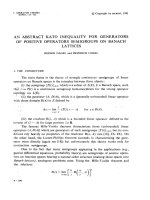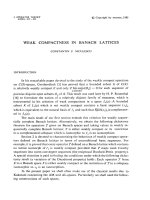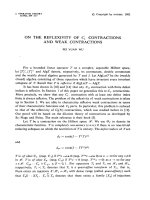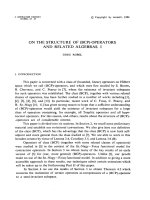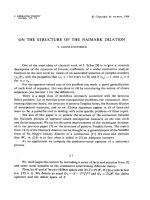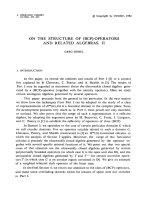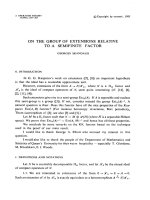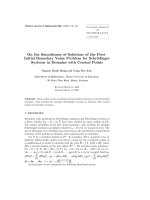Báo cáo toán học: "On the size of minimal unsatisfiable formulas" pptx
Bạn đang xem bản rút gọn của tài liệu. Xem và tải ngay bản đầy đủ của tài liệu tại đây (97.04 KB, 5 trang )
On the size of minimal unsatisfiable formulas
∗
Choongbum Lee
†
Submitted: Oct 29, 2008; Accepted: Jan 21, 2009; Published: Jan 30, 2009
Mathematics Subject Classification: 05D99(Primary); 05C15, 68R10(Secondary)
Abstract
An unsatisfiable formula is called minimal if it becomes satisfiable whenever any
of its clauses are removed. We construct minimal unsatisfiable k-SAT formulas with
Ω(n
k
) clauses for k ≥ 3, thereby negatively answering a question of Rosenfeld. This
should be compared to the result of Lov´asz [Studia Scientiarum Mathematicarum
Hungarica 11, 1974, p113-114] which asserts that a critically 3-chromatic k-uniform
hypergraph can have at most
n
k−1
edges.
1 Introduction
Given n boolean variables x
1
, . . ., x
n
, a literal is a variable x
i
or its negation x
i
(1 ≤ i ≤ n).
A clause is a disjuction of literals and by k-clause we denote a clause of size k. A
CNF(Conjunctive Normal Form) formula is a conjunction of clauses and a k-SAT formula
is a CNF formula with only k-clauses. Throughout this article formula will mean a CNF
formula and it will be given as a pair F = (V, C) with variables V = {x
1
, . . . , x
n
} and
clauses C as collection of disjunction of literals V ∪ V . A formula is called satisfiable if
there exists an assignment of values to variables so that the formula becomes true. A
formula is called minimal unsatisfiable if it is not satisfiable but removing any clause
makes it satisfiable.
Satisfiablity of a formula is closely related to the 2-colorability of a hypergraph in the
following sense. A formula is satisfiable if there is an assignment of values to variables in a
way that no clauses have only false literals inside it. Similarily a hypergraph is 2-colorable
if there is a way to color the vertices into two colors so that none of the edges become
monochromatic. A hypergraph H = (V, E) is called critically 3-chromatic if it is not 2
colorable but the deletion of any edge makes it 2 colorable. In this analogy, minimal
unsatisfiable formulas correspond to critically 3-chromatic hypergraphs. Therefore it is
∗
This research forms part of the Ph.D thesis written by the author under the supervision of Prof.
Benny Sudakov.
†
Department of Mathematics, UCLA, Los Angeles, CA, 90095. E-mail:
Research supported in part by Samsung Scholarship.
the electronic journal of combinatorics 16 (2009), #N3 1
natural to ask if similar results hold for both problems. In particular, we are interested if
the same restriction on the number of clauses (edges, respectively) holds or not.
In the case of lower bounds, roughly the same estimate holds for both formulas and hy-
pergraphs. Seymour [5] used linear algebra method to deduce that a critically 3-chromatic
hypergraph H = (V, E) must satisfy |E| ≥ |V | if there is no isolated vertex. The corre-
sponding bound for CNF formulas appeared in Aharoni and Linial [1] where they quote
an unpublished work of M. Tarsi to prove that minimal unsatisfiable formula F = (V, C)
must satisfy |C| ≥ |V | + 1 if every variable is contained in some clause.
For uniform hypergraphs there are also known upper bound results. Lov´asz [3] proved
that any critically 3-chromatic k-uniform hypergraph has at most
n
k−1
edges. This result
is asymptotically tight, as was shown by Toft [6] who constructed critically 3-chromatic
k-uniform hypergraphs with Ω(n
k−1
) edges.
Motivated by these results, Rosenfeld [4] asked if the analogy also holds for minimal
unsatisfiable k-SAT formulas.
Question. Should minimal unsatisfiable k-SAT formulas have at most O(n
k−1
) clauses?
It is not difficult to show that this conjecture is true for k = 2 and we will give the
simple proof of this in section 2. However for k-SAT formulas with k ≥ 3 we show that
surprisingly the answer for the question of Rosenfeld is negative. In section 3 we will
construct minimal unsatisfiable k-SAT formulas with Ω(n
k
) clauses.
2 2-SAT formulas
First we give explicit minimal unsatisfiable 2-SAT formulas. Consider the 2-SAT formula
F
(2)
= (V
(2)
, C
(2)
) where V
(2)
= {y
1
, y
2
, . . . , y
2l
} and C
(2)
= {y
i
∨ y
i+1
, y
i
∨ y
i+1
: i =
1, 2, . . . , 2l − 1} ∪ {y
1
∨ y
2l
} ∪ {y
1
∨ y
2l
}. F
(2)
is unsatisfiable because if y
i
= y
i+1
for some
i then either y
i
∨ y
i+1
or y
i
∨ y
i+1
is false and otherwise if y
i
= y
i+1
for all 1 ≤ i ≤ 2l − 1
then y
1
= y
2l
and this time either y
1
∨ y
2l
or y
1
∨ y
2l
will become false. To prove that
F
(2)
is minimal unsatisfiable, we only check that deleting y
1
∨ y
2
or y
1
∨ y
2l
makes the
new formula satisfiable as other clauses can be checked similarily. In each case, the
assignment of (y
1
= y
2
= false, y
3
= . . . = y
2l−1
= true, y
4
= . . . = y
2l
= false) and
(y
1
= y
3
= . . . = y
2l−1
= false, y
2
= y
4
= . . . = y
2l
= true) will make the remaining
clauses true.
Next we prove the linear upper bound of number of clauses in minimal unsatisfiable
2-SAT formulas.
Proposition 1. Minimal unsatisfiable 2-SAT formulas have at most 4n − 2 clauses.
Proof. Given a minimal unsatisfiable 2-SAT formula F = (V, C), let’s consider the im-
plication graph D of this 2-SAT formula which is the directed graph D over the vertices
V ∪ V with two directed edges corresponding to each clause z
1
∨ z
2
∈ C given as z
1
→ z
2
and z
2
→ z
1
. Aspvall, Plass and Tarjan [2] proved that 2-SAT is unsatisfiable if and only
if its implication graph has a strongly connected component which contains both x
i
and
the electronic journal of combinatorics 16 (2009), #N3 2
x
i
for some index i. Therefore the unsatisfiability of F implies the existence of directed
path from x
i
to x
i
and from x
i
and x
i
in D for some index i. Now observe that the
minimality of F forces every clause z
1
∨ z
2
∈ C to have at least one of its corresponding
edge z
1
→ z
2
or z
2
→ z
1
in these directed paths. As otherwise deleting the clause will not
change the unsatisfiability of F (because it still contains both directed paths). Since D
has 2n vertices, there can be at most 4n − 2 edges in the two directed paths. Therefore
|C| ≤ 4n − 2.
3 k-SAT formulas
In this section we construct minimal unsatisfiable k-SAT formulas on n variables with
Ω(n
k
) clauses. For simplicity we describe in details the construction of 3-SAT formulas
only. This construction can be easily generalized for all k. Informally, start with a
minimal unsatisfiable “almost” 3-SAT formula with Ω(n
3
) clauses where “almost” means
that only a small number of clauses is not of size 3. Then transform this formula into a
“genuine” 3-SAT formula by replacing the clauses of size greater than 3 by 3-clauses while
keeping the minimal unsatisfiable property. During the process the number of variables
will not increase too much and therefore we will end up with a 3-SAT formula that we
have promised. Now we should make it into a formal argument.
The following lemma will allow us to change the size of a clause in the formula. This
lemma is a modified version of Theorem 1 and 4 in [6] which were originally used by Toft
to construct k-uniform hypergraphs with Ω(n
k−1
) edges.
Let F
X
= (V
X
, C
X
), F
Y
= (V
Y
, C
Y
) be formulas with disjoint sets of variables(that is,
V
X
∩ V
Y
= ∅) and c
0
= z
1
∨ z
2
∨ . . . z
k
∈ C
X
be a k-clause of F
X
where k ≤ |C
Y
|. For an
arbitrary surjective map h from C
Y
to {z
1
, z
2
, . . . , z
k
}, let the formula F
Z
= (V
Z
, C
Z
) be
as following.
• V
Z
= V
X
∪ V
Y
C
Z
= (C
X
\{c
0
}) ∪ {c
y
∨ h(c
y
) : c
y
∈ C
y
}
Lemma 2. If F
X
and F
Y
are minimal unsatisfiable formulas, then F
Z
constructed as
above is also a minimal unsatisfiable formula.
Proof. Let’s first show that F
Z
is unsatisfiable. For arbitrary values of V
X
there must
exist a clause c
x
∈ C
X
which is false. If c
x
= c
0
then we are done as c
x
∈ C
Z
so assume
that c
x
= c
0
. Since every literal x ∈ c
0
is false, a clause of the form c
y
∨ h(c
y
) is true if
and only if c
y
is true. But F
Y
is unsatisfiable so there must exist a clause c
y
which is false
and therefore F
Z
is unsatisfiable.
Next we prove that removing any clause c
z
∈ C
Z
makes F
Z
satisfiable. First assume
that c
z
∈ C
X
\{c
0
}. Then give values to V
X
so that every clause in C
X
except c
z
is
satisfied. Since c
z
= c
0
, there must exist a literal x ∈ c
0
which is true. Pick a clause
c
∈ h
−1
(x) ⊂ C
Y
(h
−1
(x) is non-empty because h is surjective) and give V
Y
the values
which make every clause except c
in C
Y
true. Observe that every clause in C
X
\{c
0
}
except c
z
is true by values of V
X
and every clause in {c
y
∨ h(c
y
) : c
y
∈ C
y
} is true either
by values of V
Y
or the literal x. Now assume that c
z
= c
∨ x ∈
c
y
∨ h(c
y
) : c
y
∈ C
y
and
the electronic journal of combinatorics 16 (2009), #N3 3
give V
X
the values which make every clause except c
0
true and give V
Y
the values which
makes every clause except c
true. This assignment of values will make every clause but
c
z
∈ C
Z
true and thus we are done.
Next step is to construct an “almost” 3-SAT formula with many clauses. Let V
0
=
{x
1
, x
2
, . . . , x
6m
} and look at the formula F
0
= (V
0
, C
0
) with clauses given as,
• C
0
= {x
i
1
∨ x
i
2
∨ x
i
3
: 1 ≤ i
1
≤ 2m, 2m + 1 ≤ i
2
≤ 4m, 4m + 1 ≤ i
3
≤ 6m}
∪{x
1
∨ x
2
∨ . . . , x
2m
} ∪ {x
2m+1
∨ . . . ∨ x
4m
} ∪ {x
4m+1
∨ . . . ∨ x
6m
}
Informally, partition the variables V into three equal parts V
1
, V
2
, V
3
and consider
every clauses x
1
∨ x
2
∨ x
3
with x
i
∈ V
i
and add three more clauses V
1
, V
2
, V
3
. Note that
this formula contains (2m)
3
+ 3 clauses.
Claim 3. F
0
is a minimal unsatisfiable formula.
Proof. Let’s first prove that F
0
is unsatisfiable. Assume that the three clauses x
1
∨ x
2
∨
. . . ∨ x
2m
, x
2m+1
∨ . . . ∨ x
4m
, x
4m+1
∨ . . . ∨ x
6m
are all true. Then there must exist
1 ≤ i
1
≤ 2m, 2m + 1 ≤ i
2
≤ 4m, 4m + 1 ≤ i
3
≤ 6m such that x
i
1
= x
i
2
= x
i
3
= false. But
this will make the clause x
i
1
∨ x
i
2
∨ x
i
3
false. Therefore F
0
is unsatisfiable.
Now assume that we remove a clause c. If c = x
i
1
∨ x
i
2
∨ x
i
3
for some i
1
, i
2
, i
3
then
assigning x
i
1
= x
i
2
= x
i
3
= false and everything else true will make the remaining part
satisfiable. On the other hand if c = x
1
∨ x
2
∨ . . . ∨ x
2m
then assigning x
1
= x
2
= . . . =
x
2m
= true and everything else false will make the remaining part satisfiable. Similar
assignment will work for clauses x
2m+1
∨ . . . ∨ x
4m
and x
4m+1
∨ . . . ∨ x
6m
.
Construction
Note that the formula F
0
is “almost” a 3-SAT formula in the sense that there are only
three clauses whose size is not 3. Use Lemma 2 with F
X
= F
0
, c
0
= x
1
∨x
2
∨. . .∨x
2m
∈ C
0
and F
Y
= F
(2)
where F
(2)
is a minimal unsatisfiable 2-SAT formula with m variables and
2m clauses as constructed in section 2. The obtained formula F
1
is a minimal unsatisfiable
formula over 6m + m = 7m variables and has only two clauses whose size are not 3. (All
new clauses are 3-clauses.)
Repeat the same process with the remaining two 2m-clauses to obtain a minimal
unsatisfiable formula F
2
whose every clause has size 3 i.e. F
2
is a 3-SAT formula over
n = 9m variables. Note that it still contains the original 3-clauses {x
i
1
∨ x
i
2
∨ x
i
3
: 1 ≤
i
1
≤ 2m, 2m + 1 ≤ i
2
≤ 4m, 4m + 1 ≤ i
3
≤ 6m}. There are 8m
3
= (
2
9
n)
3
such clauses and
therefore this 3-SAT formula F
2
contains Ω(n
3
) clauses.
For k ≥ 4, minimal unsatisfiable k-SAT formulas with Ω(n
k
) clauses can be constructed
similarily. Use F
(k)
0
= (V
(k)
0
, C
(k)
0
) where,
• V
(k)
0
= {x
1
, x
2
, . . . , x
mk
} (m =
n
k
)
• C
(k)
0
= {x
i
1
∨ x
i
2
∨ . . . ∨ x
i
k
} : (t − 1)m + 1 ≤ i
t
≤ tm, 1 ≤ t ≤ k}
∪
∪
k
s=1
{x
(s−1)m+1
∨ x
(s−1)m+2
∨ . . . ∨ x
sm
}
the electronic journal of combinatorics 16 (2009), #N3 4
By the same process as above one can verify that F
(k)
0
is minimal unsatisfiable. Then
replace the m-clauses by k-clauses using Lemma 2 and minimal unsatisfiable (k − 1)-SAT
formulas. The final formula will be a minimal unsatisfiable k-SAT formula with Ω(n
k
)
clauses. Details are omitted.
Concluding remarks
• Toft [6] also constructed k-color critical r-uniform hypergraphs (k ≥ 4, r ≥ 2) with
Ω(n
r
) edges. Since 3-color critical r-uniform hypergraphs can have at most O(n
r−1
)
edges (Lovasz [3]), we can observe an interesting jump from 3-color critical uniform
hypergraphs to k-color critical uniform hypergraphs(k ≥ 4). A similar phenomena,
namely that minimal unsatisfiable 2-SAT formulas have O(n) clauses but there are
minimal unsatisfiable k-SAT formulas with Ω(n
k
) clauses(k ≥ 3), occurs also in the
case of formulas. It would be interesting to see a more direct connection.
• It was pointed out by the referee that based on the case k = 3, 4, 5 of the above con-
struction one can obtain a richer family of minimal unsatisfiable k-SAT formulas(k ≥
6) with Ω(n
k
) clauses as follows. Let F
1
= (V
1
, C
1
) and F
2
= (V
2
, C
2
) be a k
1
-SAT
and a k
2
-SAT minimal unsatisfiable formula respectively, on distinct sets of vari-
ables. Then the formula F
∗
= (V
1
∪V
2
, {c
1
∨c
2
: c
1
∈ C
1
, c
2
∈ C
2
}) is a (k
1
+k
2
)-SAT
minimal unsatisfiable formula on |V
1
| + |V
2
| variables and with |C
1
| × |C
2
| clauses.
We will omit the simple proof of this fact. It is worth to note that the density of
clauses in a k-SAT obtained from the original and this construction is both O(1/k
k
).
Acknowledgement. I gratefully thank Benny Sudakov for his advice and guidance and
the anonymous referee for the careful reading and valuable suggestions. I am also thankful
to Po-Shen Loh and Boris Bukh for the fruitful discussions.
References
[1] R. Aharoni, N. Linial, Minimal non-two-colorable hypergraphs and minimal unsatisfi-
able formulas, Journal of Combinatorial Theory, Series A 43, 1986, p196-204
[2] B. Aspvall, M. F. Plass, R. E. Tarjan, A linear-time algorithm for testing the truth of
certain quantified boolean formulas, Information Processing Letters 8(3), 1979, p121-
123
[3] L. Lov´asz, chromatic number of hypergraphs and linear algebra, Studia Scientiarum
Mathematicarum Hungarica 11, 1974, p113-114
[4] M. Rosenfeld, private communication
[5] P. D. Seymour, On the two-colouring of hypergraphs, Quart. J. Math. Oxford 25, 1974,
p303-312
[6] B. Toft, On Colour-critical hypergraphs, Colloquia Mathematica Societatis Janos
Bolyai 10, 1973, p1445-1457
the electronic journal of combinatorics 16 (2009), #N3 5


